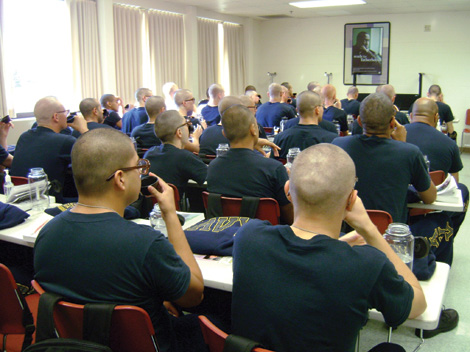Deployment of Adenovirus Vaccine

Adenovirus Type 4 and Type 7 Vaccine, Live, Oral (Adenovirus Vaccine) has been used since Oct. 24, 2011. It protects military trainees against Febrile Respiratory Illness (fever plus symptoms such as coughing and sneezing) caused by adenovirus types 4 and 7. Adenovirus Vaccine goes into the mouth of every basic trainee of the Army, Navy, Air Force, Marine Corps, and Coast Guard.
It does not get there by accident.
The U.S. Army Medical Research and Materiel Command manages the development of Adenovirus Vaccine. The Pharmaceutical Systems Division of the U.S. Army Medical Materiel Development Activity houses the product manager and support staff. The Integrated Product Team, chaired by the product manager, developed the concept for deployment and distribution of Adenovirus Vaccine well before the U.S. Food and Drug Administration licensed the vaccine in March 2011. The Milestone Decision Authority approved the basic distribution concept ' just-in-time deliveries directly from the manufacturer to the points of use ' at Milestone B and C decision reviews.
When basic trainees become ill, the U.S. government expends resources by diagnosing and treating illness, paying trainees who are too ill to train, and making adjustments to the training schedule. The use of Adenovirus Vaccine is cost-effective when the cost of vaccine is less than the sum of the costs avoided as a consequence of its use. The Acquisition Program Baseline's threshold cost per dose of Adenovirus Vaccine is the highest cost at which procurement of vaccine is favorable as assessed in a cost-benefit analysis. Under the Low Rate Initial Production contract, the Army procures Adenovirus Vaccine at a cost lower than the threshold cost. The analysis of data collected by the Naval Health Research Center shows that the use of Adenovirus Vaccine has had a very favorable impact on the FRI rate. Thanks to the use of Adenovirus Vaccine, disease caused by adenovirus types 4 and 7 is no longer an issue during basic training.
The manufacturer supplies Adenovirus Vaccine in a package of two bottles. The IPT's logistics working group, which includes the manufacturer, conducted a series of test shipments to ascertain the effectiveness of procedures for maintenance of the cold chain for Adenovirus Vaccine, which must be kept a certain temperature during transportation and storage. The results of the first test indicated a need to adjust the timing of initiation of function of the temperature-monitoring and recording device. Subsequent tests demonstrated that Adenovirus Vaccine reached all of the points of use, the nine basic training installations for the U.S. military services, within 48 hours after packing -- the duration of the period within which the packed vaccine could be reliably kept within temperature limits.
The number of shipping containers sent by commercial carrier varies from month to month and by destination. The product manager develops a shipping plan from estimates of the number of recruits who will arrive at each site. The Services need approximately 240,000 doses per year -- a figure that includes a safety margin to deal with the possibility that some doses may not be used due to problems experienced at the sites. Upon receipt of the shipping plan, the manufacturer ships the number of doses of vaccine needed to immunize recruits in a given month during the preceding month. Since shipments began in Oct. 2011, the manufacturer has shipped 100,800 doses to the training sites without incident.
The Adenovirus Vaccine Product Management Office has two links to the field, both represented on the IPT. The Distribution Operations Center of the U.S. Army Medical Materiel Agency communicates with relevant logistics personnel at each of the receiving sites to call their attention to imminent deliveries, inquire about the condition of vaccine received, and respond to any questions or concerns relating to shipments. After the receiving site personnel evaluate basic information from the temperature monitors, they ship the monitors to USAMMA-DOC, where its personnel download a complete data set and, after which, contact the manufacturer for information and advice on any questions regarding vaccine quality. The Military Vaccine Agency, or MILVAX, a component of the Office of the Surgeon General, is the IPT's link to preventive medicine staff at each installation, and to senior public health officers of each of the Services. Given these links, the product manager and IPT are well-positioned to acquire, process, and disseminate information on a timely basis, which remains critical to the distribution of this important vaccine.














